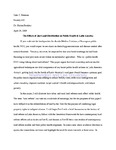| dc.rights.license | In Copyright | en_US |
| dc.creator | Petersen, Julie C. | |
| dc.date.accessioned | 2013-12-03T15:29:57Z | |
| dc.date.available | 2013-12-03T15:29:57Z | |
| dc.date.created | 2009 | |
| dc.identifier | WLURG38_Petersen_POV_2009_wm | |
| dc.identifier.uri | http://hdl.handle.net/11021/24192 | |
| dc.description | Capstone; [FULL-TEXT FREELY AVAILABLE ONLINE] | en_US |
| dc.description | Julie C. Petersen is a member of the Class of 2009 of Washington and Lee University. | en_US |
| dc.description.abstract | In this paper, I will illustrate how urban and rural land reforms each affect public health. The term "land reform" can take on a multitude of meanings, but for the purposes of this paper I have defined it as the redistribution of land by the State for the purpose of conferring legal property rights to indigent citizens. I will begin Part I with a brief discussion on the history of land reform in Latin America, follow with the theoretical framework for how contemporary land reform affects public health in Part II, and discuss in Part III three case studies of contemporary land reform models and their public health responses. In some cases where academic literature is sparse, the connections are loose and highlight the need for more research in these areas. In areas where the majority of the current academic literature on the effects of land titling focus on urban settings, this contribution demonstrates (1) which of and how these principles are applicable to the rural setting, and (2) how shifting these land redistribution programs to the countryside will alleviate health losses caused by overcrowding in urban centers. Because the relationships between land reform and public health are generally indirect, the framework of this paper draws the lines to show how various models of land reform (rural vs. urban, national vs. grassroots) influence determinants of public health (i.e. economic resources, food scarcity, migration patterns), which in turn elicit public health responses. The public health determinants I examine are: (1) economic resources, (2) housing and infrastructure, (3) food scarcity and nutrition, (4) female empowerment, and (5) migration patterns. [From introductory section] | en_US |
| dc.description.statementofresponsibility | Julie C. Petersen | |
| dc.format.extent | 31 pages | en_US |
| dc.language.iso | en_US | en_US |
| dc.rights | This material is made available for use in research, teaching, and private study, pursuant to U.S. Copyright law. The user assumes full responsibility for any use of the materials, including but not limited to, infringement of copyright and publication rights of reproduced materials. Any materials used should be fully credited with the source. | en_US |
| dc.rights.uri | http://rightsstatements.org/vocab/InC/1.0/ | en_US |
| dc.subject.other | Washington and Lee University, Shepherd Poverty Program | en_US |
| dc.title | The Effects of Just Land Distribution on Public Health in Latin America | en_US |
| dc.type | Text | en_US |
| dcterms.isPartOf | RG38 - Student Papers | |
| dc.rights.holder | Petersen, Julie C. | |
| dc.subject.fast | Capabilities approach (Social sciences) | en_US |
| dc.subject.fast | Land reform -- Government policy | en_US |
| dc.subject.fast | Land reform -- Law and legislation | en_US |
| dc.subject.fast | Public health | en_US |
| dc.subject.fast | Latin America | en_US |
| dc.subject.fast | Land titles | en_US |
| dc.subject.fast | Malnutrition | en_US |
| dc.subject.fast | Land banks | en_US |
| local.department | Shepherd Poverty Program | en_US |
| local.scholarshiptype | Capstone | en_US |
